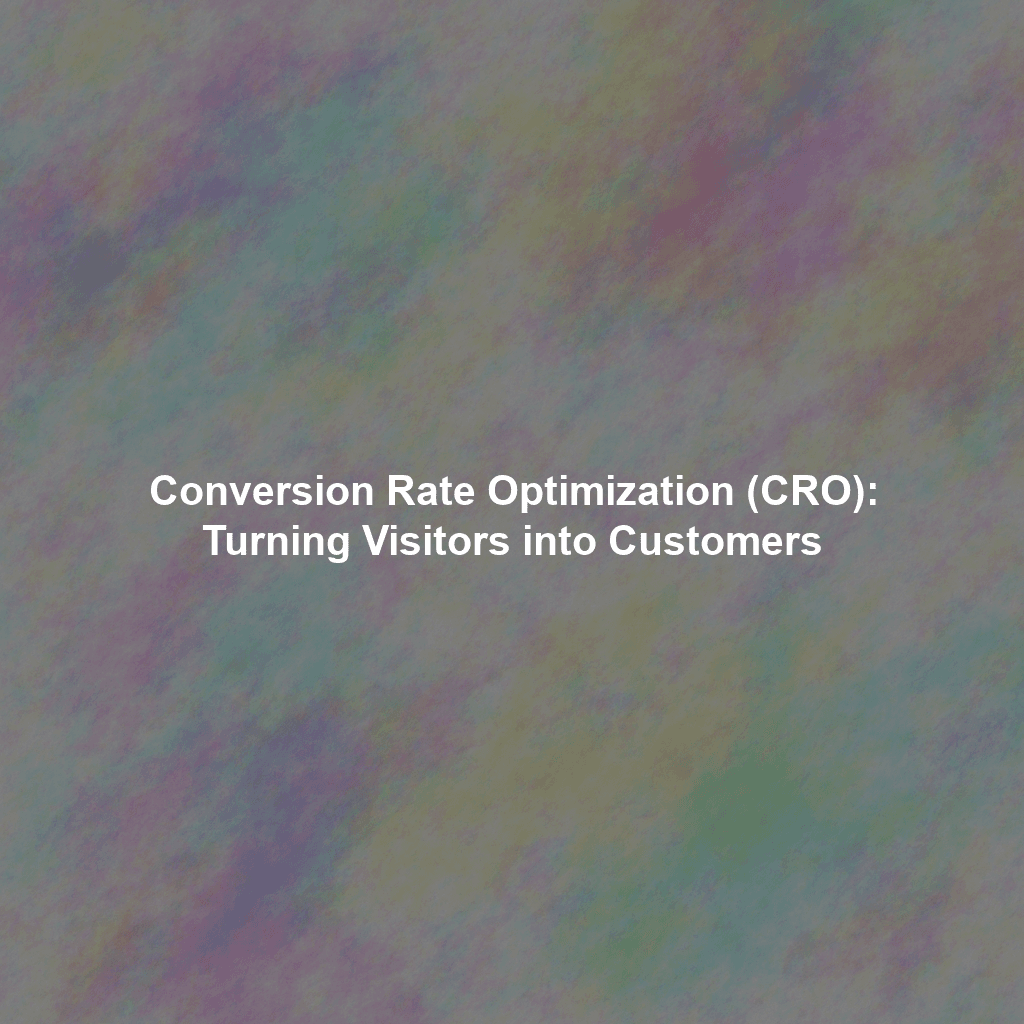What is Conversion Rate, Exactly?
Simply put, your conversion rate is the percentage of website visitors who complete a desired action. This action can be anything from making a purchase and filling out a form to subscribing to a newsletter or downloading a resource. The specific action will vary depending on your business goals.
Here’s the formula:
Conversion Rate = (Number of Conversions / Total Number of Visitors) * 100
For example, if your website had 1,000 visitors last month and 50 of them made a purchase, your conversion rate would be 5%.
Why is CRO So Important?
Investing in CRO offers a multitude of benefits, making it a worthwhile pursuit for any business with an online presence:
- Increased ROI: By converting more of your existing traffic, you can generate more revenue without spending more on advertising.
- Improved Customer Understanding: CRO involves in-depth analysis of user behavior, providing valuable insights into their needs, preferences, and pain points.
- Enhanced User Experience: CRO focuses on making your website more user-friendly, intuitive, and enjoyable, leading to happier customers.
- Competitive Advantage: A well-optimized website can outperform competitors, attracting and retaining more customers.
- Better Data-Driven Decisions: CRO relies on data and analytics, ensuring that your decisions are based on evidence rather than guesswork.
The CRO Process: A Step-by-Step Guide
CRO isn’t a one-time fix; it’s an ongoing process of experimentation and refinement. Here’s a breakdown of the key steps involved:
1. Data Collection and Analysis
The foundation of any successful CRO strategy is data. You need to understand how visitors are interacting with your website. Here are some essential tools and techniques:
- Google Analytics: Track key metrics like bounce rate, time on page, exit pages, and conversion rates for different segments of your audience.
- Heatmaps: Visualize where users are clicking, scrolling, and spending their time on your pages. Tools like Hotjar and Crazy Egg can provide valuable insights.
- Session Recordings: Watch recordings of real user sessions to see how they navigate your website and identify any usability issues.
- User Surveys and Feedback: Directly ask your visitors about their experience and what they would like to see improved.
- Customer Interviews: Conduct in-depth interviews with your customers to understand their motivations, pain points, and decision-making process.
2. Identify Problems and Opportunities
Based on your data analysis, identify areas where your website is underperforming and where there’s potential for improvement. Common areas to focus on include:
- Landing Pages: Are your landing pages relevant to the ads or search queries that brought visitors there? Are they clearly communicating the value proposition?
- Forms: Are your forms too long or complex? Are you asking for unnecessary information?
- Call-to-Actions (CTAs): Are your CTAs clear, compelling, and strategically placed?
- Website Navigation: Is it easy for visitors to find what they’re looking for? Is your website structure logical and intuitive?
- Checkout Process: Is your checkout process smooth and secure? Are there any unnecessary steps or distractions?
- Mobile Responsiveness: Is your website optimized for mobile devices?
3. Develop Hypotheses
Based on your identified problems and opportunities, formulate hypotheses about how you can improve your conversion rate. A hypothesis should be a specific, testable statement that proposes a change and predicts its impact. For example:
Hypothesis: “Changing the headline on our landing page from ‘Get a Free Quote’ to ‘Get a Personalized Quote in 60 Seconds’ will increase form submissions by 15%.”
4. Design and Implement Experiments
The most common method for testing hypotheses is A/B testing (also known as split testing). This involves creating two or more versions of a page or element and showing them to different segments of your audience. The version that performs better is declared the winner.
Other testing methods include:
- Multivariate Testing: Testing multiple variations of multiple elements simultaneously.
- Usability Testing: Observing users as they interact with your website and gathering feedback.
5. Analyze Results and Iterate
Once your experiment has run for a sufficient amount of time (typically a few weeks), analyze the results to determine whether your hypothesis was correct. If the winning version significantly outperformed the control, implement the change on your website. If not, analyze the data further to understand why and develop new hypotheses for testing.
CRO is an iterative process. Even after implementing a successful change, continue to monitor its performance and look for further opportunities for improvement.
Key Elements to Optimize for CRO
While every website is different, here are some common elements that often have a significant impact on conversion rates:
Landing Pages
Landing pages are often the first point of contact between your website and potential customers. Make sure they are:
- Relevant: Clearly connected to the ad or search query that brought the visitor there.
- Clear and Concise: Communicate your value proposition quickly and easily.
- Focused: Avoid distractions and guide visitors towards a single, clear call to action.
- Visually Appealing: Use high-quality images and videos to engage visitors.
- Mobile-Friendly: Optimized for viewing on mobile devices.
Forms
Forms can be a major barrier to conversion. Make them as easy as possible to complete by:
- Reducing the Number of Fields: Only ask for essential information.
- Using Clear Labels and Instructions: Make sure visitors understand what information you need.
- Providing Helpful Error Messages: Guide visitors towards correcting any mistakes.
- Using Autocomplete and Other Time-Saving Features: Make the process as seamless as possible.
- Ensuring Security: Reassure visitors that their information is safe.
Call-to-Actions (CTAs)
CTAs are the buttons or links that encourage visitors to take action. Make sure they are:
- Prominent: Visually distinct and easy to find.
- Action-Oriented: Use strong verbs that encourage action (e.g., “Download Now,” “Get Started,” “Learn More”).
- Benefit-Driven: Highlight the value that visitors will receive by clicking the CTA.
- Strategically Placed: Position CTAs where they are most likely to be seen and clicked.
Website Copy
Your website copy should be clear, concise, and persuasive. Focus on:
- Highlighting Benefits: Focus on how your product or service can solve your customers’ problems.
- Using Social Proof: Include testimonials, reviews, and case studies to build trust.
- Creating a Sense of Urgency: Use language that encourages visitors to take action now (e.g., “Limited Time Offer,” “While Supplies Last”).
- Using a Conversational Tone: Write in a way that is easy to understand and relatable.
Visual Design
Your website’s visual design plays a crucial role in creating a positive user experience. Pay attention to:
- Using High-Quality Images and Videos: Visuals can help engage visitors and communicate your message more effectively.
- Creating a Consistent Brand Identity: Use consistent colors, fonts, and imagery to reinforce your brand.
- Ensuring Readability: Use clear fonts, sufficient white space, and appropriate contrast to make your content easy to read.
- Optimizing for Mobile Devices: Ensure that your website looks and functions well on all devices.
Tools for Conversion Rate Optimization
Several tools can assist you in your CRO efforts. Here are a few of the most popular:
- Google Analytics: For website traffic analysis and goal tracking.
- Google Optimize: For A/B testing and personalization.
- Hotjar: For heatmaps, session recordings, and surveys.
- Crazy Egg: Another popular heatmap and session recording tool.
- Optimizely: A comprehensive A/B testing and personalization platform.
- Unbounce: A landing page builder with built-in A/B testing capabilities.
Common CRO Mistakes to Avoid
Even with the best intentions, CRO efforts can sometimes fall flat. Here are some common mistakes to avoid:
- Not Tracking Your Results: Without proper tracking, you won’t know what’s working and what’s not.
- Making Changes Based on Gut Feeling: Base your decisions on data and analysis, not assumptions.
- Testing Too Many Things at Once: Focus on testing one element at a time to isolate the impact of each change.
- Not Testing Long Enough: Allow your experiments to run for a sufficient amount of time to gather statistically significant data.
- Ignoring Mobile Users: Ensure that your website is optimized for mobile devices.
- Assuming What Works for Others Will Work for You: Test everything on your own audience.
Beyond the Basics: Advanced CRO Techniques
Once you’ve mastered the fundamentals, you can explore more advanced CRO techniques, such as:
- Personalization: Tailoring the website experience to individual users based on their behavior, demographics, or other characteristics.
- Behavioral Targeting: Showing different content or offers to users based on their past behavior on your website.
- Exit-Intent Popups: Displaying a popup message when a user is about to leave your website.
- Dynamic Content: Changing the content of a page based on the user’s location, device, or other factors.
The Future of CRO
CRO is constantly evolving, driven by advancements in technology and changes in user behavior. Expect to see more emphasis on:
- Artificial Intelligence (AI): Using AI to analyze data, personalize experiences, and automate testing.
- Voice Search Optimization: Optimizing your website for voice search queries.
- Mobile-First Design: Designing websites primarily for mobile devices.
- Privacy-Focused CRO: Adapting CRO strategies to comply with evolving privacy regulations.
Conclusion
Conversion Rate Optimization is a continuous journey, not a destination. By embracing a data-driven approach, understanding your audience, and consistently testing and refining your website, you can significantly improve your conversion rates and achieve your business goals. Start small, focus on the key elements, and gradually expand your efforts as you gain experience. The rewards of a well-optimized website are well worth the investment.
 Skip to content
Skip to content

